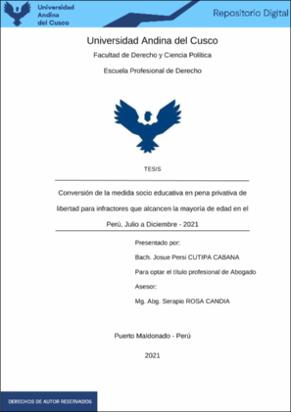| dc.contributor.advisor | Rosa Candia, Serapio | |
| dc.contributor.author | Cutipa Cabana, Josue Persi | |
| dc.date.accessioned | 2022-11-09T14:39:18Z | |
| dc.date.available | 2022-11-09T14:39:18Z | |
| dc.date.issued | 2021-12-14 | |
| dc.identifier.uri | https://hdl.handle.net/20.500.12557/4908 | |
| dc.description.abstract | En el presente trabajo de tesis nos propusimos como objetivo general; Establecer las
razones que justifican la conversión de las medidas socio educativa en pena privativa
de libertad para los adolescentes infractores que alcancen la mayoría de edad en el
Perú; para lo cual se revisó material bibliográfico, informes estadísticos de la propia
institución, diagnósticos de los centros juveniles y recomendaciones de diferentes
entidades del estado y los informes, publicaciones de los medios de comunicación y
otras fuentes.
En cuanto a la metodología utilizada en la presente investigación, es el enfoque
cualitativo dado que no se apoya en mediciones estadísticas, sino en categorías de
análisis, de tipo dogmático propositivo, puesto que se orienta a establecer la
modificación de una norma jurídica, que permita la conversión de las medidas
socioeducativas por la pena privativa de la libertad.
En cuanto a los resultados obtenidos de la investigación realizada, se evidencia que los
adolescentes infractores no están alcanzando, la rehabilitación, reeducación y
resocialización para integrarse a la sociedad y su familia como ciudadano de bien, se
encuentra varios factores que contribuyen a ello como: deficientes infraestructura,
reducidos personal y la renuencia al tratamiento de los adolescentes infractores debido
que muchos ya alcanzaron la mayoría de edad.
Nuestra legislación nacional sobre adolescentes infractores no tiene previsto el traslado
a los adolescentes que alcanzaron la mayoría de edad a un penal de adulto,
expresamente indica que deben de permanecer en los centros juveniles, pero en la
legislación comparada existe experiencias diferentes con respecto al mismo tema, como
la de España, cuando tienen un adolescente infractor internado y alcanza la mayoría de
edad realizan una audiencia para variar su medida bien sale en libertad o continua su
medida en un penal de adultos. | es_PE |
| dc.description.abstract | In this thesis work we set ourselves as a general objective; Establish the reasons that
justify the conversion of socio-educational measures into a custodial sentence for
juvenile offenders who reach the age of majority in Peru; for which bibliographic material,
statistical reports of the institution itself, diagnoses of the youth centers and
recommendations of different state entities and the reports, publications of the media
and other sources were reviewed.
Regarding the methodology used in this research, it is the qualitative approach since it
is not based on statistical measurements, but on categories of analysis, of a propositive
dogmatic type, since it is aimed at establishing the modification of a legal norm, which
allows the conversion of socio-educational measures to imprisonment
Regarding the results obtained from the research carried out, it is evident that the
adolescent offenders are not reaching the rehabilitation, reeducation and re-socialization
to integrate into society and their family as a good citizen, there are several factors that
contribute to this, such as: poor infrastructure, reduced staff and reluctance to treat
adolescent offenders because many have reached the age of majority.
Our national legislation on adolescent offenders does not provide for the transfer of
adolescents who have reached the age of majority to an adult prison, it expressly
indicates that they must remain in juvenile centers, but in comparative legislation there
are different experiences regarding the same issue , as in Spain, when they have an
adolescent offender admitted and he reaches the age of majority, they hold a hearing to
vary his measure, either he is released or continues his measure in an adult prison. | en_US |
| dc.format | application/pdf | es_PE |
| dc.language.iso | spa | es_PE |
| dc.publisher | Universidad Andina del Cusco | es_PE |
| dc.rights | info:eu-repo/semantics/openAccess | es_PE |
| dc.rights.uri | https://creativecommons.org/licenses/by-nc-nd/4.0/ | es_PE |
| dc.subject | Adolescente infractor | es_PE |
| dc.subject | Mayor de edad | es_PE |
| dc.subject | Establecimiento penal | es_PE |
| dc.title | Conversión de la medida socio educativa en pena privativa de libertad para infractores que alcancen la mayoría de edad en el Perú, julio a diciembre - 2021 | es_PE |
| dc.type | info:eu-repo/semantics/bachelorThesis | es_PE |
| thesis.degree.name | Abogado | es_PE |
| thesis.degree.grantor | Universidad Andina del Cusco. Facultad de Derecho y Ciencia Política | es_PE |
| thesis.degree.discipline | Derecho | es_PE |
| dc.publisher.country | PE | es_PE |
| dc.subject.ocde | https://purl.org/pe-repo/ocde/ford#5.05.00 | es_PE |
| renati.advisor.dni | 10727380 | |
| renati.advisor.orcid | https://orcid.org/0000-0002-3551-9246 | es_PE |
| renati.author.dni | 43041711 | |
| renati.discipline | 421016 | es_PE |
| renati.juror | Vásquez Rodríguez, Miguel Ángel | |
| renati.juror | Puma Sacsi, Miguel Ángel | |
| renati.juror | Ochoa Saire, Fredy | |
| renati.juror | Polanco Chavez, Silvia Antonieta | |
| renati.level | https://purl.org/pe-repo/renati/level#tituloProfesional | es_PE |
| renati.type | https://purl.org/pe-repo/renati/type#tesis | es_PE |


